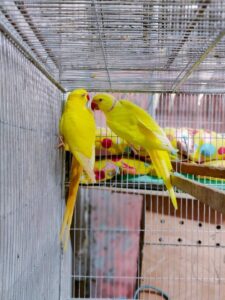Owning a pet bird that talks can be an incredibly rewarding experience. These avian companions not only provide the joy of their presence but also engage you with their ability to mimic words, sounds, and even phrases. In this article, we’ll explore the most popular pet birds that talk, their unique characteristics, and tips for encouraging your feathered friend to speak.
1. African Grey Parrot: The Master of Mimicry
The African Grey Parrot is often considered the best talking bird in the avian world. Known for their exceptional intelligence and remarkable ability to mimic human speech, these parrots can develop a vocabulary of hundreds of words.
Key Features:
- Vocabulary: Can learn over 1,000 words and phrases.
- Lifespan: 50-60 years with proper care.
- Personality: Highly intelligent, social, and affectionate.
- Training: Requires consistent interaction and mental stimulation.

African Greys are known to not only mimic words but also understand their context, making them highly communicative pets. They thrive in environments where they receive plenty of attention and mental challenges.
2. Budgerigar (Budgie): The Smallest Talker
Budgies, also known as parakeets, are small in size but big in personality. They are one of the most popular pet birds worldwide and are known for their ability to mimic human speech.
Key Features:
- Vocabulary: Can learn 100-200 words.
- Lifespan: 10-15 years.
- Personality: Playful, curious, and social.
- Training: Responds well to repetition and positive reinforcement.
Budgies are often underestimated as talking birds due to their small size, but with proper training and patience, they can become excellent talkers. Their chirpy voices add charm to their speech, making them delightful companions.
3. Amazon Parrot: The Entertainer
Amazon parrots are vibrant, social birds that love to entertain. Known for their expressive voices and strong personalities, they can be wonderful talking pets.
Key Features:
- Vocabulary: Can learn 300-500 words.
- Lifespan: 40-50 years.
- Personality: Energetic, playful, and affectionate.
- Training: Enjoys interactive training sessions with plenty of rewards.
Amazon parrots are not just great talkers; they are also known for their singing abilities. Their clear, expressive voices make them stand out, and they often mimic the tone and pitch of their owners’ voices.
4. Indian Ringneck Parakeet: The Clever Conversationalist
Indian Ringneck Parakeets are known for their sharp minds and clear voices. They are highly intelligent birds that can develop an impressive vocabulary with proper training.
Key Features:
- Vocabulary: Can learn 200-250 words.
- Lifespan: 20-30 years.
- Personality: Independent, inquisitive, and charming.
- Training: Requires consistent practice and social interaction.
These birds are quick learners and can pick up words and phrases with ease. Their unique ring around the neck and their talking ability make them a popular choice among bird enthusiasts.
5. Quaker Parrot: The Chatty Companion
Quaker Parrots, also known as Monk Parakeets, are known for their sociable nature and talking abilities. They are relatively small but have a strong, clear voice.
Key Features:
- Vocabulary: Can learn 100-150 words.
- Lifespan: 20-30 years.
- Personality: Social, energetic, and affectionate.
- Training: Responds well to regular interaction and repetition.
Quaker Parrots are known to form strong bonds with their owners and enjoy mimicking sounds and words they frequently hear. They are also quite expressive and can learn to communicate their needs effectively.
6. Cockatiel: The Whistler and Talker
Cockatiels are not just known for their charming whistles but also for their ability to talk. While they might not have as extensive a vocabulary as some other parrots, they can learn to say a few words and phrases.
Key Features:
- Vocabulary: Can learn 10-50 words.
- Lifespan: 15-20 years.
- Personality: Gentle, affectionate, and playful.
- Training: Enjoys learning through repetition and gentle encouragement.
Cockatiels are particularly good at mimicking tunes and simple words. Their sweet nature and ease of care make them a popular choice for beginners.
Tips for Encouraging Your Bird to Talk
Training a bird to talk requires patience, consistency, and a positive environment. Here are some tips to help your feathered friend develop their talking abilities:
- Start Early: Begin training your bird as soon as possible. Younger birds tend to learn faster and are more adaptable to new skills.
- Use Repetition: Repetition is key when teaching your bird to talk. Repeat the words or phrases you want your bird to learn daily.
- Positive Reinforcement: Reward your bird with treats, praise, or affection when they attempt to speak or mimic sounds. This encourages them to continue trying.
- Speak Clearly: Always speak clearly and slowly when teaching your bird new words. Birds mimic what they hear, so clear enunciation is crucial.
- Interactive Environment: Keep your bird in an interactive environment where they are exposed to human speech regularly. This could include placing their cage in a busy room or playing recordings of words you want them to learn.
- Be Patient: Some birds take longer to learn than others. We should take some times and patience is a must for this.
Conclusion
Owning pet birds that talk can be a truly delightful experience, adding a unique dimension to your household. Whether you’re drawn to the intelligence of the African Grey or the playful nature of the Budgie, there’s a talking bird out there for everyone. By providing your bird with the right environment, training, and care, you can enjoy the wonderful companionship of a pet bird that talks for many years to come.
If you’re considering adding a talking bird to your family, remember that each species has its own personality and care requirements. Take the time to research and choose a bird that fits your lifestyle and preferences. With love and dedication, your feathered friend will soon be chatting away, bringing joy and laughter into your home.
